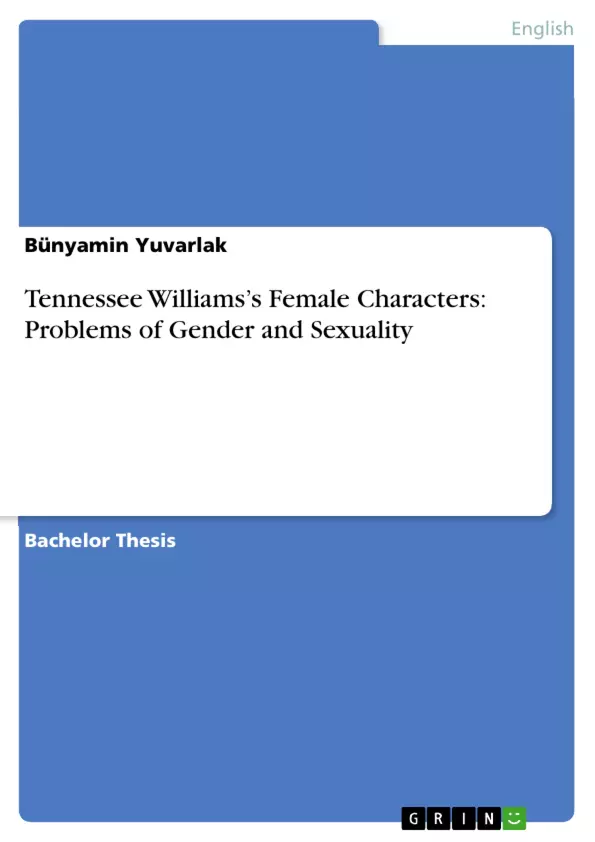The goal of the paper is to identify features relating to homosexual identity, based on a characterization of Williams’s female characters.
Among other studies, Tennessee Williams’s work has commonly been researched from a gay study perspective by literary scholars and queer theorists. The motive for that was mostly Williams’s own homosexuality and the stigma that surrounded the issue around the time he published his most famous pieces. He has written plays which explicitly involve the topic of homosexuality, as the eminent Cat on a Hot Tin Roof, but most of his work does not embrace homosexuality precisely.
Nevertheless, on the grounds that literary studies is fairly limitless, for literature provides many different fields for analyses, it is possible to involve literary pieces into the field of gay studies, even though it initially does not specify the matter.
The arguably most interesting element in Tennessee Williams’s drama are his characters, many of whom seem to share similar characteristics as struggling individuals. Analyzing the fictional characters with regard to gay writing could help find a possible pattern, draw conclusions about the influence of Williams’s personality, and thus, support the assumption that homosexuality is integrated in his plays.
Gender is also fundamental for an approach based on sexuality. Taking that into consideration, below, the focus will be on Williams’s female characters, especially on the protagonists Laura Wingfield from The Glass Menagerie and Blanche DuBois from A Streetcar Named Desire. These women are not necessarily gay themselves; in the plays, there is no clear evidence about them being sexually or romantically attracted to the same sex. Instead, sexuality is a broad concept with more meanings attached to it, which will further be discussed in the third chapter.
Table of Contents
- Introduction
- Cognitive and Gender-Specific Approach to Characterization in Drama
- Homosexuality in 20th Century American Literature
- Gay Writing
- Queer Reading of Tennessee Williams's Drama
- Williams's Female Characters
- Explicitness and Themes
- Gender and Sexuality: Characterizing Blanche DuBois and Laura Wingfield
- Gay Themes
- Character Constellation
- Gender Roles
- Conclusion
- Works Cited
Objectives and Key Themes
This bachelor thesis aims to analyze the female characters of Tennessee Williams's plays from a gay studies perspective. It investigates how Williams's own homosexuality and the social context of the time might have influenced his portrayal of women. The paper explores the potential connection between female characters and themes of homosexuality in Williams's work, particularly focusing on Blanche DuBois from A Streetcar Named Desire and Laura Wingfield from The Glass Menagerie.
- The impact of gender and sexuality on characterization in drama
- The representation of homosexuality in 20th-century American literature
- The potential for reading Williams's female characters through a queer lens
- The relationship between Williams's personal life and his creative work
- The analysis of themes, character constellations, and gender roles in selected plays.
Chapter Summaries
- Introduction: This chapter sets the stage for the analysis by introducing the key focus on Tennessee Williams's female characters and their potential connection to themes of homosexuality. It outlines the goals and methodology of the thesis, highlighting the importance of considering both cognitive and gender-specific approaches to characterization.
- Cognitive and Gender-Specific Approach to Characterization in Drama: This chapter delves into the theoretical framework for understanding characterization in drama. It explores how readers perceive fictional characters as real people and how social schemata influence their interpretation. The chapter introduces the concept of “cognitive stylistic” methods and the role of gender in characterization.
- Homosexuality in 20th Century American Literature: This chapter provides context by discussing the historical and social landscape surrounding homosexuality in 20th-century American literature. It explores the challenges faced by queer writers in addressing homosexuality in their work and the impact it had on both queer and non-queer readers.
- Gender and Sexuality: Characterizing Blanche DuBois and Laura Wingfield: This chapter is dedicated to the in-depth analysis of two of Williams's most famous female characters. It examines their characteristics, relationships, and interactions within the context of the plays. The chapter focuses on identifying potential connections between their portrayals and themes of homosexuality.
Keywords
This thesis explores the intersection of gender, sexuality, and characterization in the works of Tennessee Williams. Key concepts include gay writing, queer reading, female characters, character constellation, gender roles, and the gay experience. The analysis focuses on the influence of Williams's personal life on his work and the potential for reading his female characters through a lens of homosexual identity.
- Quote paper
- Bünyamin Yuvarlak (Author), 2017, Tennessee Williams’s Female Characters: Problems of Gender and Sexuality, Munich, GRIN Verlag, https://www.grin.com/document/998184



